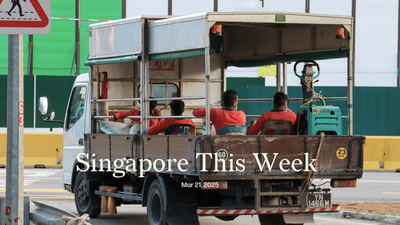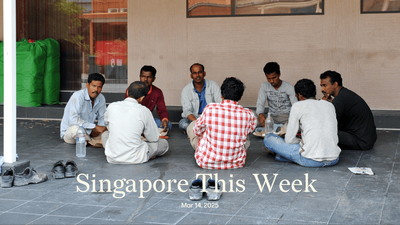Politics: Return of the ‘Doc’
“So I’m back up in the game, running things to keep my swing, letting all the people know, that I’m back to run the show,” sang Mark Morrison in “Return of the Mack”. These vibes surely emanated around West Coast Market last Saturday, when Tan Cheng Bock, chairman of the Progress Singapore Party (PSP), went on a walkabout and declared that he’s open to running in the next general election (GE), which must be held by November 2025. “If you believe in active ageing, I shouldn’t retire, right?” the 83-year-old told the media, in a cute twist of a government leitmotif. His possible return may surprise political observers. Following his West Coast team’s narrow loss to the ruling People’s Action Party (PAP) in GE2020, Tan declined to take up the non-constituency member of Parliament (NCMP) seats offered to the “best losers”. They went to his colleagues Hazel Poa and Leong Mun Wai, current party chief, who’ve since won the admiration of many young Singaporeans for their willingness to challenge the PAP on key issues, even in the face of shocking, elitist denigrations. Tan’s potential return will please his fans and worry the PAP. A corruption scandal has already ended the political career of S Iswaran, its West Coast team’s lead, and any reputational damage may have lingering effects on a key contest. Tan, a medical doctor, has had a long and storied political career. He joined the PAP and entered Parliament in 1980, going on to earn a reputation as a backbencher unafraid to speak his mind. Having left Parliament in 2006, Tan lost the presidential election (PE) to the PAP’s preferred candidate in 2011. In 2017 he could not even contest in the PE, for the government had controversially amended the Constitution to limit that year’s election to Malays. (“Tan Cheng Block,” some cried.) He formed the PSP in 2019, arguing that while Lee Kuan Yew’s administration worked “for the many”, today’s PAP works “for the few”. He attracted many disillusioned ex-PAP followers, notably Lee Hsien Yang, the elder Lee’s second son who’s estranged from his brother, the prime minister. (The current PSP is the closest embodiment of a PAP “split”.) Some of Tan’s views are anachronistic, particularly on women’s rights. In 2012 he said that aspiring female politicians, because of the heavy workload, had to “get the permission of [their] husband.” Last year he, along with some other opposition leaders, endorsed Tan Kin Lian for the presidency, despite the candidate’s troubling history of sexist, if not misogynistic, posts. And so as much as he’s liked across the political spectrum, the biggest risk of any return is that “Doc” ends up slowing the transition in the PSP away from his endearing personality cult. Is he “back to run the show” or just assist his protégés?
Some further reading: Jom’s “Q&A with Leong Mun Wai of the Progress Singapore Party”
Society: The looming threat of AI-generated deepfake porn
Cyberbullying, defamation, impersonation and image-based sexual abuse are among the top instances of online harm experienced by Singaporeans, according to local women’s group SG Her Empowerment (SHE). While SHE hasn’t observed a stark increase in technology-facilitated sexual violence in Singapore, it warns of the rise of deepfake pornography. Deepfakes are dangerously convincing images or videos that have been digitally manipulated such that subjects are depicted saying or doing something they didn’t, such as the video of Lee Hsien Loong, prime minister and Lawrence Wong, deputy prime minister “promoting” an investment platform that popped up last December. The recent boom in artificial intelligence (AI)-supported tools has drastically lowered production costs. Worryingly, sexually explicit deepfakes have grown in popularity, including AI-generated child pornography in Japan and the recent images and videos of Taylor Swift that went viral on X. “With increasingly sophisticated encrypted platforms and generative artificial intelligence, victims may not only find themselves unknowingly featured in explicit content, but also face difficulty in securing evidence and reporting such advanced forms of online harms,” Sugidha Nithiananthan from the Association of Women for Action and Research (AWARE) told The Straits Times. In 2022, 50 percent of cases of unwanted sexual behaviour at AWARE’s Sexual Assault Care Centre were facilitated by digital technology, including revenge porn and sexually harassing messages. It’s difficult to scrub the internet clean of any sort of content, hence many deepfake victims worry that their fraudulent images might resurface even after the original is gone. “We are doing a good job in the physical space, but we are a bit behind [sic] on the online space,” said K Shanmugam, minister for home affairs and law at the Online Harms Symposium last September. Comparing the results of two different surveys, Shanmugam highlighted the fact that 92 percent of respondents felt safe walking alone at night while only two-thirds felt safe online. With the introduction of the Online Safety (Miscellaneous Amendments) Act and the Online Criminal Harms Act, the government will be able to issue directions to “disable access” or “restrict the exposure” of online criminal activities and content they deem “egregious”. Critics will undoubtedly worry about potential government overreach with any censorship tool, although Shanmugam noted that individuals surveyed want “practical solutions” to the problem and the top priority is to “stop the harm first”. As AI becomes more sophisticated and accessible, the need for public education, such as digital literacy and fact-checking skills, and multi-faceted solutions to online harms, including stricter guidelines on social media and faster response times when it comes to removing deepfake content, only grows stronger.
Society: Your health (data) is at risk
Imagine that you, and any trusted healthcare provider, could access your medical history 24/7 on the cloud. You’d no longer have to remember what your drug allergies were, and worry where you stored that X-ray or cholesterol reading. This has been the promise of electronic medical records for decades. (The Singapore vision of “One Patient, One Health Record” began in the 1990s.) But concerns around data privacy and security have impeded its progress. Your medical data is valuable, and not just to you. Healthcare providers and hospitals have been a favoured target of cyber criminals. Last year, the global healthcare sector incurred the highest data breach costs for the 13th consecutive year. Closer to home, Singapore saw its worst cyber-attack in 2018 when the databases of SingHealth were hacked; particulars of 1.5m patients were stolen, including the outpatient prescriptions of Lee Hsien Loong, the prime minister. In 2021, hackers stole personal details of hundreds of thousands of Fullerton Health Group clients and peddled the digitised loot online. More recently, a distributed denial-of-service attack on public healthcare institutions shut down, for hours, access to services that required the internet. With the city-state’s proposed Health Information Bill being introduced in mid-2024, strengthening cyber and data security across the sector is more critical than ever. One of the Bill’s significant changes requires all licensed healthcare providers to upload key patient information to the National Electronic Health Records (NEHR), a centralised system that stores patients’ records containing their medical histories. This aims to facilitate more seamless and better care delivery under Healthier SG, Singapore’s national preventive care strategy. In theory, all this sounds promising, but in practical terms is likely to be “time-consuming”, as one doctor told CNA. Some have argued that the focus on digitisation and documentation could further reduce personalised face-to-face patient care and vital doctor-patient interaction, which is “the very soul of medicine”. It’ll also require additional manpower and IT resources that many private clinics, especially the smaller ones, might not have. Ahead of the changes, doctors here have called for more funding and technological support, as well as ethical guidance from the government. Healthcare practitioners’ ability to access and contribute data on the NEHR in a secure and effective manner will be key to fulfilling the broader goals of Healthier SG, ultimately benefitting patients. But how this is achieved without compromising the care, safety and privacy of Singaporeans will determine the level of trust in the healthcare system.
History Weekly by Faris Joraimi
This week marks 50 years since the famous 1974 Laju Incident, when four individuals—two from the Japanese Red Army (JRA) and two from the Popular Front for the Liberation of Palestine (PFLP)—tried to destroy the Shell oil refinery on Pulau Bukom. Failing which, they hijacked a ferry named “Laju” and held its crew members hostage. The story and its denouement are well-known, and its heroes—including then-MINDEF intelligence chief SR Nathan—remembered. Shuttle diplomacy involving the Japanese ambassador and the Egyptian charge d’affaires in Singapore led to the safe release of the hostages and the ejection of the “Bukom bombers”. Both the JRA and PFLP, designated as terrorist groups by the US, are communist organisations committed to global anti-imperialism. The PFLP specifically, founded by Palestinian Christian George Habash in 1967, is also a resistance movement: one among other Palestinian groups formed to achieve liberation from Zionist occupation following the Six-Day War. Why were they in Singapore? In an act of solidarity with the revolutionary forces of North Vietnam, the attack aimed to disrupt the oil supply from Singapore feeding the US-backed South Vietnamese regime. Official memory of the Laju episode, calling this Singapore’s first brush with “international terrorism”, assumes our innocence from participation in a global capitalist network that also depends on violence to maintain its interests. This has its roots in the British colonial enterprise, when Singapore served as the glittering administrative and financial hub for a system of exploitation whose true horrors our city’s residents were often insulated from. The Vietnam War, in which US forces killed thousands of civilians, was enabled in part by Singapore, as a link in the American-led, post-war logistical chain—that the JRA-PFLP attack tried to disrupt. Far from benign, the international state system has proven capable of enacting similar, if not worse, acts of terror against the innocent. From the murder of Saudi journalist Jamal Khashoggi to the thousands being slaughtered in Myanmar today, state perpetrators of terror are rarely held accountable. One may argue that the system’s “weak” members, like Singapore, have little agency to reform a structure that they also rely on for security. But are they really safer for it? Any principled stand against violence must also be attended by understanding the broader contexts that contribute to it. “Terrorism” will always be a feature, not a bug, of a coercive and unequal world order.
Arts: What exactly is a “Singapore” theatre company?
After 30 years of non-repertory programming, the former Singapore Repertory Theatre has rebranded itself as the Singapore Theatre Company (STC). They acknowledged their polarising previous title on their social media platforms (“we’ve never actually been [a repertory company] in the true sense of the word”) perhaps not realising that their new name would raise even more eyebrows. A repertory company is generally understood as one that produces plays from a specific stock (i.e. a repertoire) on regular rotation, where actors have the luxury of familiarising themselves with long-running work. While a few local theatre companies have managed to restage and sell out critically acclaimed productions (the STC included), sustaining a repertory theatre remains almost impossible in Singapore, where there isn’t enough of a domestic or tourist audience to keep up marathon performances the way the West End or Broadway can. The STC now describes itself as “a theatre company that is rooted in Singapore, but also reaches out to the world”, and their new logo incorporates a little red dot. What does it mean to be a flagship arts company bearing the country’s name? Online, artists wondered aloud if the STC is truly representative of Singapore—because the company isn’t commonly associated with producing or exporting local theatre (well, “The LKY Musical” excluded). The popular non-profit is perhaps best known for its annual champagne-and-picnic-basket Shakespeare in the Park, as well as its ability to attract legendary theatre doyens—Peter Brook, Sam Mendes, Simon McBurney—staging the Euro-American canon and starring the likes of Ian McKellen and (now-disgraced) Kevin Spacey. “They’re taking Singapore’s name in vain!” bemoaned one theatre practitioner, but we’re all still, collectively, negotiating what that means. If being and representing Singapore means hiring local, and contributing to capability development, STC has done that with its residency programmes for directors, and its commitment to building disability access into its shows. If it means wrestling with the sociopolitical urgencies and emotional preoccupations of the city-state, then almost any other theatre company here would have more claim to the brand name. The central dilemma is between multiple visions of theatre in Singapore: commercial success internationally, critical success locally, or any combination thereof. This is a matrix on which STC and everybody else striving here sits, the navigation of which treads the thin and difficult line between espousing nativism and an interrogation of what constitutes an artistic national identity. But if we want to do away with the deification of Singapore Inc, there are many other sacred cows we’ll need to slaughter.
Arts: Time, and time again—two exhibitions
The passages and perceptions of time form the foundations of two separate but resonant image-based exhibitions at art spaces DECK and Objectifs – Centre for Photography and Film. The Objectifs exhibition, curated by the winner of their annual curator open call Goh Chun Aik, dams up the relentless stream of time with the metaphor of the reservoir. Goh imagines the work of five artists as various “tributaries” that feed into a whole range of fluid timescales, from millenia to the millisecond. A ceramic and wood installation cycles through growth and decay in an alternate timeline without humans; another series of photographs vibrates with the motion blur of bodies in action. Through a series of brief talks and an exhibition tour on Saturday (February 3rd), the artists and curator will discuss their practices and processes, explaining how viewers might encounter time differently through the accumulated memories, chronologies and trajectories of their work. DECK’s show travels across the Causeway as part of its “Crossing SEA” contemporary photography series, where seven Malaysian artists examine nation and selfhood through both historical and natural phenomena, marking time with the monsoons, but also the urban ebb and flow of construction and demolition. Their temporal interventions are distinctly sociopolitical: Ahmad Fuad Osman’s satirical “Recollection of Long Lost Memories” inserts the artist into moments from Malaysia’s colonial history, while Vincent Leong’s digital manipulation sets abandoned housing development projects against luxury views. Patrons of these arts centres can also contribute to a broader durational project both spaces are embarking on: fundraising. DECK is building a three-storey home along Prinsep Street for their galleries, a blackbox, research library and bookstore; the nearby Objectifs, which recently turned 20, is hoping to raise S$600,000 over the next three years to expand not only their physical space but also their creative ones through workshop and residency offerings. Unlike their temporally elastic exhibitions, there’s a time limit to these goals, so supporters of lens-based art shouldn’t wait too long to make an investment.
Tech: Accelerating Singapore’s AI strategy with industry giants
To realise Singapore’s national AI ambitions, several government agencies and Google Cloud announced joint initiatives, such as the second edition of AI Trailblazers 2.0 and the new Google for Startups Accelerator to fast-track the development and adoption of generative AI solutions among organisations and start-ups respectively. In its first year of the accelerator programme, 20 start-ups will receive access to Google Cloud’s AI tech stack, advisory support from Google’s engineers and up to US$350,000 (S$468,000) in Google Cloud credits upon graduation from the programme. To develop a “sustainable pipeline of AI talent”, there are also plans to upskill 3,000 mid-career professionals through Google Career Certificate scholarships, and to integrate Google Cloud’s advanced training modules into polytechnic curricula. Separately, Singtel launched Nxera, a dedicated AI data centre brand, that will support regional AI development by leveraging key partnerships, such as with Nvidia for AI infrastructure, and Sembcorp for renewable energy. (Data centres gobble energy and Nxera plans to achieve net-zero emissions by 2028.) Meanwhile, Nxera’s Regional Sustainable Data Centre Academy will promote skills development across South-east Asia. Both Google and Singtel are adopting a holistic approach encompassing technology enablement, start-up nurturing, skills development and curriculum transformation that leverages the expertise of key industry players. It demonstrates their commitment to building “a vibrant ecosystem”, where the public and private sectors can collaborate to realise AI’s full potential. Other than Singapore, South Korea is also making a strong push to grow the AI industry with the help of local conglomerates.
Tech: SEA-LION gains traction and builds inclusion in South-east Asia
The challenges that technology platforms have had in dealing with South-east Asia’s linguistic diversity are well-known, none more so than with Facebook’s inability to moderate hate speech in Myanmar. Thankfully, it appears as if AI is about to be more inclusive for the non-English speaking parts of the region. Tokopedia and SingTel subsidiary NCS are testing SEA-LION, the large language model (LLM) developed by AI Singapore, to validate its utility across diverse use cases and languages. Given the astronomical cost and ability of Open AI’s models, there was initial scepticism about SEA-LION’s relevance in the region. However, SEA-LION’s ability to understand and generate responses tailored for South-east Asia’s multicultural audiences sets it apart from existing English-focused LLMs. For e-commerce players such as Tokopedia, it creates opportunities to remove language barriers and better serve cross-border customers. NCS has suggested plausible use cases in legal and customer service functions that have multi-language versions which could also benefit from AI-powered translations. This trial phase will provide valuable feedback on SEA-LION’s performance to strengthen its capabilities. Once complete, SEA-LION has the potential to accelerate the digital transformation of South-east Asian businesses and public services. Sceptics have often argued that one reason South-east Asia will never be as integrated as, say, China or the EU, is because of the lack of a common language. Can AI help?
If you enjoy Jom’s work, do get a paid subscription today to support independent journalism in Singapore.








